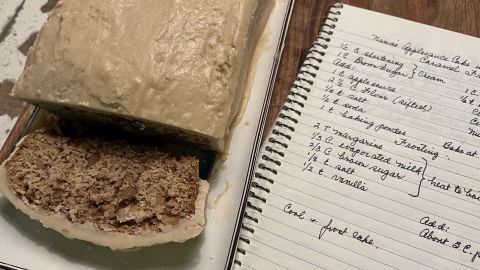Editor’s Note: Susan Puckett is a James Beard Award-nominated food journalist and editor who has authored or collaborated on more than a dozen books. She was the food editor for The Atlanta Journal-Constitution for nearly 19 years. Her writing can be found at susanpuckett.com. The views (and recipe) in his article are her own. Read more opinion at CNN.
CNN —
A year ago, we couldn’t have imagined people being so fearful of running out of eggs that they’d turn to smuggling cases across the Mexican border or renting chickens with portable coops to keep them in steady supply. But here we are.
A jaw-dropping surge in egg prices — triggered in part by shortages resulting from last year’s massive avian flu outbreak— has done wonders for raising the stature of this humble grocery staple, which has been relatively inexpensive and readily available through most of our lifetimes.
Many of us have taken to scrolling the internet for egg-free alternatives. Advice abounds online, for example, on the tastiest tofu scramble. And when it comes to baking, various pureed fruits and vegetables can serve as a binding agent in the way that eggs do.

Lately, savvy vegan bakers have mainstreamed the idea of whipping aquafaba, the liquid drained off a can of chickpeas or white beans, as they would egg whites, and folding them into batters to lighten them.
Also in baking, bananas, dates, pumpkins, sweet potatoes, and avocado can sometimes be substituted for eggs. Silken tofu, yogurt, and chia or flax seeds, which turn to gel when soaked in liquid, can also do the trick.
These clever workarounds are intriguing. But having no dietary restrictions, I had never been curious enough to try them out for myself. The other day, however, I decided to bake a cake from an old family recipe — not just because of what was in it, but what wasn’t.
I came across Nana’s Applesauce Cake with Caramel Frosting while flipping through the spiral-bound notebook of recipes my grandmother, who we called “Dodie,” had written out by hand some 30-plus years ago for my sister and brother-in-law’s first Christmas together.
As the food writer of the family, I have become the guardian of this precious heirloom, and harbored the idea that I might actually make some of these recipes and polish them up to spread among Dodie’s other offspring.
This particular recipe was one Dodie had inherited from her mother, aka “Nana,” whose baking skills were legendary. Scanning its ingredients, I could practically smell the cozy spices of cinnamon, nutmeg, and cloves wafting from Nana’s wood-burning stove.
A wave of nostalgia swept over me as I opened cupboard doors and happily realized I already had everything I needed to make it. But oddly, one ingredient this recipe didn’t call for was eggs.

No eggs? Why was that? Could Dodie have left them out by mistake? Eggs, after all, are as fundamental to cake-baking as flour and sugar. Any food scientist can explain the chemistry of how they provide richness, moisture, levity, and structure like no other ingredient, while ensuring that the cake browns properly and doesn’t crumble at first bite.
Undoubtedly our Nana, baker-extraordinaire that she was, intuited all of this. Perhaps there were egg shortages in her day too. Or maybe substituting other ingredients for eggs was a way to economize – it’s hard to say for sure.
When substituting eggs in baking, one ingredient gets recommended more often than any other: applesauce. And that was the case in this eggless cake recipe of Nana’s. I could finally use up those nearly-forgotten little plastic tubs hiding on a back shelf before they expired.
Before I started making a mess in my kitchen, I reached out to an expert for a quick consult: my longtime friend Anne Byrn, who has authored more than a dozen books on baking, including “The Cake Mix Doctor” series, and writes a bi-weekly Substack called “Between the Layers” focused on this subject.
In devising a handful of vegan cake recipes for her most recent cookbook, “A New Take on Cake,” she experimented with all those alternatives and concluded that applesauce, hands-down, was her favorite.
“Applesauce is really like this magical ingredient,” she told me. “A lot has to do with the pectin which acts as a binder as well as an emulsifier, pulling the other ingredients together, much in the way that eggs do.”

She also noted that unsweetened applesauce is cheap, convenient, and mild enough to meld easily with any number of flavors, as her vegan chocolate cake recipe with Nutella frosting attests.
Our forebears, she pointed out, had this figured out long before any of us did. In her previous book, “American Cake,” she shares a recipe for applesauce cake from a 1917 book, “Everyday Foods in Wartime” that regarded conserving scarce and costly ingredients such as butter and eggs as an act of patriotism.
The ingredients are similar to the ones called for in Nana’s recipe, and by my calculations, she very well could have come up with her version around the same time, when she would have been eking out a living to support her growing family by running a boarding house in Milwaukee.
My trust in Dodie’s immaculate cursive interpretation restored, I followed her recipe nearly to the letter. (Sorry, Nana, I couldn’t resist subbing butter for the margarine.) It turned out beautifully: denser than egg-leavened cakes, but moist and highly scarfable, even more so with the thick layer of caramel icing encasing it.
I called Anne back to report my success. “I think the lesson in all of this is that we’ve become so accustomed to having eggs at our disposal, we limit ourselves in learning more about baking,” she mused.
If you want to experiment with substituting applesauce for eggs in a cake recipe, she suggests using 1/4 cup applesauce for each egg called for.
“So maybe instead of agonizing over egg shortages, we lean into the challenge and try to connect with similar experiences before us. We might learn something new,” she told me.
“Plus, it’s cake after all. It’s going to be delicious. And if it doesn’t quite live up to our expectations, well, that’s what frosting’s for.”
Serves 8-10
I made this recipe of my great-grandmother’s according to how it was written, with a few adjustments for clarity. Although it dates back at least a century, its old-fashioned taste will likely never go out of style. The applesauce provides the necessary moistness and binding that eliminates the need for eggs.
Cake:
2 ½ cups all-purpose flour (plus extra for dusting the pan)
1 teaspoon baking powder
½ teaspoon baking soda
½ teaspoon salt
½ teaspoon ground cloves
½ teaspoon ground cinnamon
½ teaspoon ground nutmeg
½ cup shortening (plus extra for greasing the pan)
1 cup packed brown sugar
1 cup unsweetened applesauce
1 cup chopped walnuts
Frosting:
2 tablespoons margarine (or butter)
⅓ cup evaporated milk (plus a little more, if needed)
⅔ cup packed brown sugar
½ teaspoon vanilla
3 cups powdered sugar
1. Make the cake: Preheat the oven to 350 degrees. Grease and flour a 9-by-5-inch loaf pan; set aside.
2. In a medium bowl, sift together the flour, baking powder, baking soda, salt, cloves, cinnamon, and nutmeg.
3. In a large bowl with an electric mixer, beat the shortening and brown sugar on medium speed until well-blended. Blend in the applesauce.
4. Pour the dry mixture into the wet mixture and stir just until combined. Fold in the walnuts. Pour into the prepared pan and bake in the preheated oven for 30-35 minutes, or until a toothpick inserted in the center comes out clean. Remove from the oven and let it cool in the pan for about 10 minutes. Then remove from the pan and let it cool completely on a wire rack.
5. Make the frosting: In a small saucepan, bring the margarine or butter, the ⅓ cup evaporated milk, the brown sugar, and salt to a boil over medium-high heat. Remove from the heat, add the vanilla and powdered sugar, and stir vigorously with a wooden spoon until smooth.
6. Spread the frosting over the cake immediately while the frosting is still warm. If it becomes difficult to spread, heat a little milk in the same saucepan and drizzle over the top to loosen it up. Let the frosting firm up completely before slicing.
7. Wrap the leftover cake in foil or plastic wrap and store at room temperature for up to 4 days.


